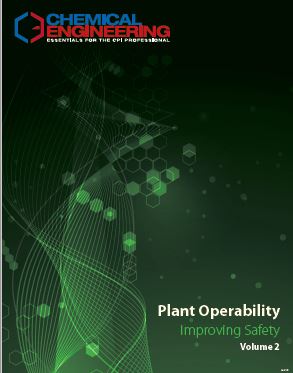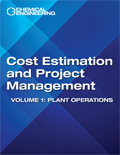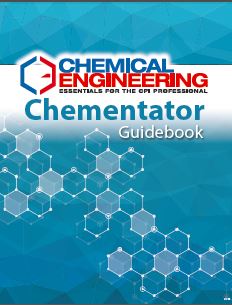Description
Improved plant operability goes hand in hand with improved plant safety. This Chemical Engineering Guidebook contains a collection of tutorial-style articles aimed at ensuring safe plant operations.
Topics relate to fire prevention and the safe handling of powders and bulk solids to reduce the risk of dust explosions. There is focus on the safe handling of heat-transfer fluids to safeguard the processes they serve, and the appropriate handing of liquefied natural gas.
Tips and best practices are provided specifying rupture disks and emergency-shutdown valves, and for monitoring corrosion and equipment integrity to prevent failures. Several articles center around pipeline safety and mechanical seals, and other engineering options that are available to minimize fugitive emissions and leaks that threaten personnel, the community and the environment.
210 pages, delivered in a PDF format.
Articles Include:
A Safety-Centered Approach To Industrial Lighting
• The proper design and operation of lighting is essential to ensure plant safety and support good maintenance practices
Designing Safer Process Plants
• Several often-overlooked strategies to increase inherent safety are discussed here
A Safety Checklist For Laboratories
• These nine best practices for managing change in laboratories can help ensure a safe workplace
Advanced Control Methods for Combustion
• Advanced control techniques can raise efficiency and lower pollutant emissions in industrial combustion. The capabilities and adoption of several methods are discussed
Hot-Oil Heat-Tracing Systems
Engineering for Plant Safety
• Early process-hazards analyses can lead to potential cost savings in project and plant operations
Maintaining Heat-Transfer-Fluid Quality
Integrity of Aging Assets: Using Corrosion
Data to Stave Off Extinction
• Petroleum refineries built in the 1960s and 1970s have trouble dealing with the corrosive effects of modern feedstocks.
Continuous monitoring of corrosion can prevent process equipment failures
Chemical Protective Clothing
Static Electricity Discharge and Fire Prevention
Liquefied-Industrial-Gas Safety
Heat Transfer Fluid Leaks: Break the Fire Triangle
• Extreme processing temperatures present the greatest risk. Know where leaks are most likely to occur and how to prevent them
Clearing the Air About Respiratory Protection
• Learn the basics about selection and regulatory compliance for these potentially life-saving devices
Fire-Water Pumps for CPI Facilities
• Follow this guidance to improve the selection, design and operation of pumps handling water for firefighting and related systems
Common Mistakes When Conducting a HAZOP and How to Avoid Them
• An important part of ensuring the success of a HAZOP study is to understand the errors that can cause the team to lose focus
Pump Safety: Flirting with Disaster
• Be vigilant about parallel pumping conditions that can lead to catastrophic failures
Eye-and-Face Personal Protective Equipment
• Protecting the eyes and face in the workplace is imperative to preventing the estimated 10–20% of work-related eye injuries that result in temporary or permanent vision loss
Flare Consolidation Considerations
• Consolidating multiple flares can help mitigate emissions and maintenance
Finding the Right Gloves To Fit the Application
• There is a wide range of gloves available for hand protection on the job. Matching gloves to their chemical-resistance properties is one criterion for selection
Dust Control in the Chemical Processing Industries
• The prevention of dust hazards in the CPI is integral to process safety management — wide reaching mitigation schemes must be implemented
Things You Need to Know Before Using an Explosion-Protection Technique
• Understanding the different classification methods is necessary to better select the explosion-protection techniques that will be used
The Integral Role of Waste Management in Capital Projects
• To avoid unnecessary efforts and mitigate risks, all phases throughout the design and implementation of large capital projects should incorporate comprehensive planning for waste management
Rupture Discs: Effectively Minimize Leaks and Emissions
• When installing rupture discs, there are several mechanical and operational considerations for reducing the likelihood of leaks and fugitive emissions
Avoid Safety Pitfalls During Plant Expansion and Modification
• Follow this guidance to minimize risk when adding or modifying plant equipment
Combining the use of Rupture Discs with Relief Valves
• Using the two devices together offers significant benefits in chemical processes. Here is how to take advantage of them
Why Bad Things Happen to Good Steam Equipment
• Accounting for an entire steam-trap population is crucial to avoiding safety incidents and suboptimal production — high-priority consideration must be given to steam-system management
Rotating Machinery: What You Should Know About Operational Problems
• Follow this guidance to improve the operation, safety and reliability of rotating machinery in chemical process plants
Chemical Protective Clothing
• ISO 16602 offers a much-needed, common global language for expressing protective clothing performance
Piping-System Leak Detection and Monitoring for the CPI
• Eliminating the potential for leaks is an integral part of the design process that takes place at the very onset of facility design
Anti-surge Valves for Dynamic Compressors
• Follow this guidance to improve the selection and sizing of anti-surge valves for axial and centrifugal compressors
Dust Explosions: Prevention & Protection
• Understand what causes these disasters and then put these practical measures in place
Burner Inspection and Maintenance
• Burners and their components can be quite complex. Establishing maintenance and inspection best practices encourages long term operational reliability
Critical Connections Demand Certainty
• Understanding bolts’ behavior during routine tightening procedures helps to ensure leak-free, reliable operations
Safety in Sulfuric Acid Storage Tanks
• Commonly used in the CPI, sulfuric acid requires many special precautions to ensure its safe handling and storage
Emergency Shutdown Valves: A Functional Safety Approach to Selection
• The relationship between valve selection and safety certification still causes confusion. A focus on functional safety can help to elucidate
Preventing Dust Explosions
• Risk management programs are critical for safe handling and processing of combustible dust as well as for OSHA regulatory compliance
The Next Step Change in Process Safety
• Leveraging the convergence of operational and information technologies can aid in minimizing risk
Coupler Technologies for Secure Chemical Handling
• Significant improvement in reducing fluid loss, optimizing flow paths and easing operation are among the advances in next-generation coupler technologies
Avoid Common Mistakes When Specifying Burner Management Systems
• While some aspects of burner management systems may seem intuitive, overcoming misconceptions in their specification and design will help to elevate overall safety
Reduce Risk and Cost with a Lifecycle Approach to Process Safety
• Better upfront planning and management can lead to safer, more productive processes throughout every phase of operation
Calculate NPSH with Confidence
• Determining net positive suction head (NPSH) can be confusing, but with these guidelines, engineers can avoid the pitfalls of incorrect calculations
Heat-Transfer Fluid Selection
An Overview of Vacuum System Design
• The design of vacuum systems deserves careful attention — there are multiple facets that affect efficiency, operability and cost
Selecting Laboratory Exhaust Systems
• With upfront thought, exhaust systems can ensure personnel safety and improve building efficiency
Mechanical Seals Update: Pharmaceutical and Food Applications
• For applications that require cleanliness, be sure your centrifugal pumps have the proper seals




